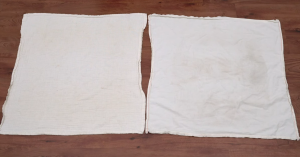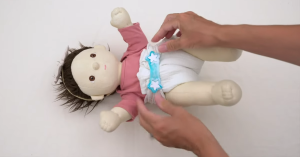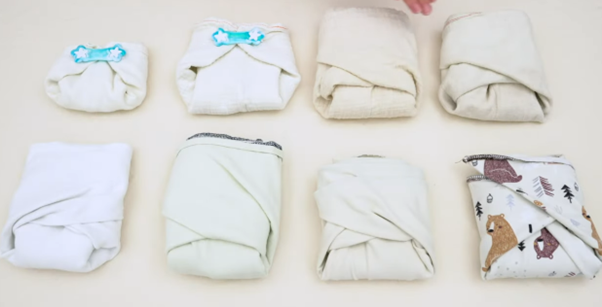Flat cloth diapers -The Beginner’s Guide (2023)
What Are Flat Cloth Diapers?

Flat cloth diapers, often called flats, are a wallet-friendly and versatile choice for cloth diapering. These diapers are large, thin squares of absorbent fabric in different materials and folding styles.
Flats can be resized, and their absorbency adjusted by folding them differently.
You can use diaper pins or fasteners to keep them snugly in place. They also work well as inserts for pocket diapers when folded to the correct size. They’re thin, so flat diapers dry quickly.
To prevent leaks, cover them with a waterproof cloth diaper cover. To sum it up, flat cloth diapers are a timeless and budget-friendly option for keeping your baby comfortably diapered.
How to Use Flat Cloth Diapers?

Prepare your flat cloth diaper using the origami fold, which may appear complicated initially but gets easier with practice.
Add an extra absorbent layer in the middle. Carefully slide the diaper under your baby, lift the center part, and secure the wings around your baby’s tummy.
Benefits of Flat Cloth Diapers
Affordable: Flat cloth diapers are a budget-friendly diapering system, costing roughly $2 per diaper for basic cotton, making them an economical choice for parents.
Quick Drying: These diapers dry rapidly, even when hung on a clothesline. This feature is particularly convenient for activities like camping or where handwashing and line-drying are necessary.
Versatile Sizing: Flat diapers can serve from infancy until your child is ready for potty training.Their folds can be customized to fit your baby’s size and your preferred fit, providing flexibility as your child grows.
Easy to Clean: Cleaning flat cloth diapers is a breeze as they consist of a single layer of fabric, making rinsing out any mess straightforward.
Customizable Absorbency: Like prefold diapers, flat diapers can be customized to suit your baby’s absorbency needs by folding them differently.
Material Options: While cotton is a common material, bamboo and hemp blends are also available, providing choices for parents who prefer alternative fabrics.
Cost-Effective: In terms of cost, they are comparable to prefold diapers, depending on the materials and brands chosen.
Environmental-Friendly: Cloth diapers, including flat ones, are environmentally friendly as they reduce the waste of disposable diapers.
Reusable: Flat cloth diapers reduce long-term diapering costs and waste.
Flexible: Unlike other cloth diapering systems, flat diapers are not pre-sewn into a diaper fold, offering more flexibility in how you fold and use them.
Suitable for Multiple Situations: Their affordability, quick drying time, and ease of cleaning make flat cloth diapers ideal for various situations, including outdoor activities and travel.
Flat Cloth Diapers Are Economical
Flat cloth diapers are budget-friendly and represent the most basic and straightforward form of cloth diapering. They consist of a large segment of absorbent material that you fold and secure around your infant. The uncomplicated nature of flat cloth diapers simplifies cloth diapering and makes it a cost-effective choice.
Flat Cloth Diapers Are Easy to Dry
Parents often find themselves in situations where a speedy diaper turnaround is essential. Flats are covered whether you prefer air and sun drying outdoors or need a quick solution when running low on clean diapers.
Air and Sun Drying Outdoors
Hanging your flat cloth diapers in the great outdoors is a fantastic way to harness the power of the sun and fresh air. This approach not only accelerates drying time
Sunlight acts as a natural bleach, effectively removing stains and disinfecting the diapers, leaving them fresh and clean.
Convenient Indoor Drying
Sometimes, convenience is key. If you have a dwindling diaper supply and a laundry load in progress, you can wash a single flat cloth diaper in a flash. Flats dry in just a matter of minutes when hung indoors.
Flats Are Easy to Fold
Folding flat cloth diapers is straightforward, even for those new to cloth diapering.
Unlike more complex diaper systems, flats offer simplicity and ease of use. Whether using the classic origami fold or opting for the “pad fold,” you’ll appreciate the straightforwardness of preparing flats for your baby. Pg checked
The Cons of Flat cloth diapers
While flats have many advantages, it’s also essential to consider their limitations. These include:
Lack of Built-in Fasteners: Unlike some modern cloth diapers, flats require additional fasteners like diaper pins or snappis to secure them.
Bulky Appearance: Flats can appear more overweight compared to some of the trimmer diapering options available.
Extra Laundry: Due to their single-layer design, flats may require more frequent changing and washing.
Potential Comfort Barrier: Dads, caregivers, and grandparents may not be comfortable using them, affecting their willingness to participate in diaper changes.
What Are Flats Cloth Diapers Made of?
While most flat cloth diapers are made from 100% birdseye cotton, Hemp Babies has introduced an amalgam of hemp and organic cotton composed of 55% hemp.; however, Hemp Babies has introduced an amalgamation comprising 55% hemp and 45% organic cotton. Typically, flat cloth diapers boast dimensions of approximately 27″x 27″ or 70cm x 70 cm once they have undergone the pre-washing process.
What is Birdseye Cotton?
A flat cloth diaper is made with birdseye cotton, a specific type of fabric. This 100% cotton material derives its name from its distinctive weave pattern, which resembles small diamond-shaped openings akin to a bird’s eye view.
While it may initially appear somewhat stiff when purchased, what makes birdseye cotton remarkable is its remarkable transformation over time.
As this cotton fabric is used and washed, it gradually softens and becomes more absorbent. This characteristic makes birdseye cotton an excellent choice for diapering, as it becomes increasingly gentle against your baby’s skin while enhancing its ability to retain moisture.
In addition to its evolving softness and absorbency, birdseye cotton boasts exceptional durability, making it a preferred material for crafting flat cloth diapers. Its longstanding reputation in cloth diapering attests to its reliability and effectiveness.
Flour Sack Tea Towels
Flour sack tea towels have gained attention as a practical alternative to traditional flat cloth diapers. These towels are budget-friendly and versatile, making them an attractive option for cloth diapering.
Typically made of cotton, they are highly absorbent. Flour sack tea towels are gaining popularity among parents as an affordable and easily accessible alternative to traditional flat cloth diapers.
These versatile towels are typically available in the housewares section of retail giants like Wal-Mart and Target, with a price tag of approximately $1 per piece. They are constructed from a lightweight woven fabric comprising 100% cotton.
It’s worth noting that while the flour sack tea towels found at Wal-Mart are absorbent, they may not match the thickness or quality of birdseye cotton flats, such as the OsoCosy brand.
Birdseye cotton flats are renowned for their exceptional absorbency and durability. However, one significant advantage of flour sack tea towels is their convenience and accessibility.
Most people live near a Wal-Mart or Target store, where these towels can be easily acquired. In contrast, purchasing traditional flats may require online orders, potentially incurring shipping costs and delays.
This accessibility factor makes flour sack tea towels a practical choice for parents seeking an economical diapering solution.
Why should I consider hemp as opposed to cotton?
Hemp has emerged as a viable alternative to traditional cotton for cloth diapering. While cotton remains a popular choice, hemp offers several distinct advantages. Hemp fabric is incredibly durable and known for its longevity.
It can withstand frequent washes and the test of time, making it an environmentally friendly choice.
Additionally, hemp is highly absorbent, which means fewer leaks and more extended periods between diaper changes. Hemp can be a better choice than cotton due to these reasons.
More Absorbent and Better Breathability: Hemp is inherently more porous than cotton, allowing it to absorb moisture more effectively. This enhanced absorbency keeps your baby drier and provides better breathability, reducing the risk of diaper rash.
Exceptional Durability: Hemp fabric is remarkably tough and can easily endure the rigors of diapering more than one child. Its durability means you’ll get more mileage from your hemp flat cloth diapers, making them a cost-effective choice in the long run.
Natural Antimicrobial Properties: Hemp possesses natural antimicrobial properties, reducing the chances of bacteria and mildew developing within the fabric. This quality helps maintain the hygiene and freshness of the diapers, keeping your baby comfortable and healthy.
Sustainable Farming Practices: Hemp cultivation is characterized by sustainable farming practices. In contrast, growing cotton is resource-intensive, often requiring pesticides and nitrogen fertilizer.
Conversely, hemp enriches the soil by adding nutrients like nitrogen and doesn’t rely on pesticides, making it an eco-friendly choice for conscientious parents.
Hand-Washing Flats
While modern washing machines have made diaper laundering more convenient, hand-washing flats are still viable, especially for those who prefer a more hands-on approach.
Flat cloth diaper sizes chart
| Size | Approx. Weight and Age | Approx. Measurements Before Washing (inches) | Approx. Measurements After Washing (inches) |
| Birdseye Size Half | 4-8 lbs | 17.5 x 28 | 16 x 27 |
| Muslin Newborn | 7-12 lbs | 20 x 28 | 19 x 27 |
| Birdseye One-Size | 6-35+ lbs (Birth to 3 years) | 28 x 29 | 28 x 28 |
| Muslin One-Size | 12-35+ lbs (Birth and up) | 28 x 30 | 28 x 28 |
| Birdseye Large Organic | 12-45 lbs (3 months and up) | 33 x 35 | 32 x 32 |
| Muslin XL/Swaddle | 39 x 39 | 35 x 35 |
Please note that sizes are approximate, and shrinkage may vary by an inch or more in either direction after Washing.
What is the difference between Pre fold cloth diapers and flat cloth diapers?
Pre fold v/s flat cloth diapers
| Aspect | Flat cloth Diapers | Pre fold Cloth Diapers |
| Construction | Single sheet of absorbent fabric | Multiple layers sewn together |
| Ease of Use | Require folding and fastening | Easier to use with less folding |
| Absorbency | Less absorbent than prefolds | More absorbent, especially when layered |
| Cost | Economical; budget-friendly | Affordable but slightly more expensive than flats |
| Durability | Long-lasting with proper care | Durable and withstand frequent washing |
| Customization | Highly customizable with folding techniques | Foldable but less versatile |
| Fast Drying | Quick drying due to single layer | May take longer to dry, especially when layered |
| Modern Options | Less common in modern cloth diapering | Still popular and widely used |
Pre folds + Flats vs. Fitted cloth diaper flats
Choosing the right diapering system can be a challenge for parents.
This section will analyze the advantages and disadvantages of blending pre fold and flat cloth diapers instead of opting for fitted cloth diapers. Making a well-informed choice aligned with your preferences and your baby’s needs will be easier when you understand the differences between these diapering systems.
There are many options when it comes to cloth diapering. While some parents prefer the affordability and simplicity of prefolds and flats, others opt for the convenience and performance of fitted cloth diapers. Let’s delve into why we believe each option has its merits:
| Aspect | Pre folds & Flats | Fitted Cloth Diapers |
| Cost-Effective | Extremely economical; budget-friendly. | Initial investment may be higher, but long-term savings in covers. |
| Ease of Use | Require pins or snappi fasteners and snug-fitting covers. | Fully elasticized, no-pins-needed design for easy use. |
| Containment | Lack elastics, may require frequent cover changes. | Excellent poop containment, reducing cover changes. |
| Absorbency | May need multiple layers for overnight use. | Highly absorbent, often sufficient without additional boosting. |
| Versatility | Available in sized and one-size-fits-all options. | Offered in both One Size and Sandy’s sized diapers. |
| Convenience | Quick to dry, ideal for air drying. | Convenient for active babies and nighttime use. |
| Customization | Flexibility in folding to adjust absorbency. | Snap closures for a snug fit, especially on wiggly toddlers. |
| Usage Recommendations | Suitable for various situations but may require more covers. | Ideal for nighttime and long car rides; fewer cover changes needed. |
For Whom are Flat Cloth Diapers Best for?

Flat cloth diapers are best suited for budget-conscious parents, eco-conscious families, experienced cloth diaper users, those willing to put in extra effort, and parents seeking quick drying times. They offer an affordable and eco-friendly diapering option with the flexibility to customize folding.
How Much Do Flat Cloth Diapers Cost?
Flat cloth diapers are budget-friendly, typically costing around $2.50 each. In contrast, fitted cloth diapers are a bit pricier, with a typical one costing approximately $14.24 each. When managing your family budget, it’s essential to consider the cost of diapers and other expenses.
Are Flats or Pre folds Better?
When comparing flats and pre folds, many parents prefer pre folds due to their layered construction, which often results in better absorbency. Pre folds are particularly suitable for newborns and preemies. Their smaller sizes make them easier to use, especially when compared to flats.
Do Flat Diapers Need a Diaper Cover?
Flat cloth diapers require folding into various configurations to form a multi-layered, diaper-like structure. You can secure flat diapers with safety pins or clips. Additionally, flats necessitate a diaper cover to help contain moisture within the diaper.
FAQs
Q-1 Which insert is best for cloth diapers?
Choose the best cloth diaper inserts based on absorbency and materials like microfiber, cotton, bamboo, and hemp, and consider variations like velour and terry for specific needs.
Q-2 What is the difference between flat and Pre flat diapers?
Pre flats are a hybrid diaper option that combines stretchy flats with added absorbency, offering versatility and convenience. They are made from stretchy knit fabrics like Bamboo/Cotton French Terry and often feature additional absorbent layers, such as high GSM bamboo fleece, which can be sewn, snapped, or laid within the stretchy shell.
Q-3 Which type of diaper is most absorbent?
Rumparooz Pocket and Pampers swaddlers Overnights are among the top-performing cloth and disposable diapers regarding absorbency. They excel at locking moisture away from a baby’s skin, preventing sogginess, and reducing the likelihood of diaper rash. These diapers are known for their high absorbent capacity.
Q-4 Which diapers are the most natural?
The Honest Company offers top-quality, non-toxic baby diapers known for being free from harmful substances like parabens, latex, perfumes, chlorine, and more. The diapers are plant-based and sustainably made, with a core from pine and spruce trees.
Q-5 Are hemp flat cloth diapers more expensive than cotton ones?
Hemp cloth diapers may cost more initially, but they are a wise choice in the long term due to their durability. They last longer, making them more cost-effective overall. Hemp’s superior absorbency also means fewer diaper changes, contributing to savings.
Q-6 Can I use regular detergent for washing flat cloth diapers?
Using a cloth diaper-friendly detergent is recommended to maintain the longevity and effectiveness of your flat cloth diapers. Regular detergents may contain additives that can affect the absorbency and overall performance of the diapers.
Q-7 Do flat cloth diapers require special folding techniques?
Flat cloth diapers offer various folding options to suit your baby’s size and needs. While there are no strict rules, learning a few folding techniques can help optimize the diaper’s fit and absorbency.
Q-8 How many flat cloth diapers do I need for a newborn?
The required numbers of flat diaper for a newborn depends on the baby’s age, how often you plan to do laundry, and your preferred diapering method. It is advisable to have around 24 to 36 flat cloth diapers for newborns on average as a good starting point.
Q-9 Are flat cloth diapers suitable for overnight use?
Flat cloth diapers can be used for overnight diapering, but you may need to add extra layers or boosters for extended absorbency. The effectiveness of overnight use may vary depending on your baby’s sleeping habits and fluid intake.
Q-10 What are stretchy flat cloth diapers?
These flat diapers are slightly stretched, enabling a tidy and snug fold when adjusting them for the baby’s use.
Q-11 Are muslin flat diapers suitable?
Muslin offers an economical choice for cloth diapers and boasts excellent absorbency and quick-drying properties. This combination reduces the risk of diaper leaks and ensures the fabric dries rapidly.
So, What are Flat cloth diapers?
Flat cloth diapers are an excellent choice for a sustainable, budget-friendly, eco-friendly solution. They are a practical alternative that can help reduce waste while saving you money in the long run.
So, whether it’s the simplicity of flat diapers or the absorbency of pre folds, cloth diapers remain a timeless and responsible choice for modern parent
Also read:
Types of cloth diapers

